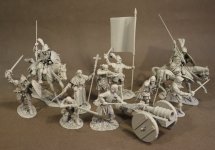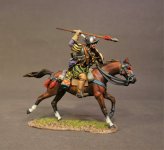SPANISH CONQUISTADORS
Previewed at the June London Toy Soldier show on Saturday June 30th were the prototypes of the first of the Spanish Conquistadors

From the moment of Christopher Columbus' discovery of lands previously unknown to Europe in 1492, the New World captured the imagination of European adventurers. Thousands of men came to the New World to seek fortune, glory, and land. For two centuries, these men explored the New World, conquering any native people they came across in the name of the King of Spain (and the hope of gold). They came to be known as the Conquistadors.
The word conquistador comes from Spanish and means "he who conquers."
Conquistadors claimed that they were attacking the New World natives in order to spread Christianity and save the natives from ****ation. Many of the conquistadors were, indeed, religious men, but history has shown that the conquistadors were far more interested in gold and loot.
The Aztecs and Inca Empires were rich in gold, silver, and precious stones. Conquistadors who participated in any successful campaign were given shares based on many factors. The king and the expedition leader (Hernan Cortes) each received 20% of all loot. After that, it was divided up among the men.
Conquistadors were not a standing army; in the New World they were more like mercenaries. They were free to join any expedition they wanted to and could theoretically leave at any time. They were organized by units: footmen, harquebusiers, cavalry, etc. served under trusted captains who were responsible to the expedition leader.
Armor and weapons were crucially important for a conquistador. Footmen had heavy armor and swords made of fine Toledo steel. Crossbowmen had their crossbows, tricky weapons which they had to keep in good working order. The most common firearm at the time was the harquebus, a heavy, slow-to-load rifle; most expeditions had at least a few harquebusiers along. Horsemen used lances and swords.
In Mexico, most conquistadors eventually abandoned their heavy armor in favor of the lighter, padded protection the Mexicans used.
Many thanks to Clive and Sue Gande of GREY GOOSE COLLECTIBLES for their continued support and hard work.

**PLEASE NOTE THE FIRST OF THE CONQUISTADOR FIGURES WILL BE AVAILABLE FROM SEPTEMBER 2018**
**PLEASE NOTE THAT THERE WILL BE NO NEW RELEASES FOR JULY 2018. JJDESIGNS WILL BE CLOSED FROM JULY 15th. NORMAL BUSINESS WILL RESUME FROM AUGUST 1st 2018**
Previewed at the June London Toy Soldier show on Saturday June 30th were the prototypes of the first of the Spanish Conquistadors

From the moment of Christopher Columbus' discovery of lands previously unknown to Europe in 1492, the New World captured the imagination of European adventurers. Thousands of men came to the New World to seek fortune, glory, and land. For two centuries, these men explored the New World, conquering any native people they came across in the name of the King of Spain (and the hope of gold). They came to be known as the Conquistadors.
The word conquistador comes from Spanish and means "he who conquers."
Conquistadors claimed that they were attacking the New World natives in order to spread Christianity and save the natives from ****ation. Many of the conquistadors were, indeed, religious men, but history has shown that the conquistadors were far more interested in gold and loot.
The Aztecs and Inca Empires were rich in gold, silver, and precious stones. Conquistadors who participated in any successful campaign were given shares based on many factors. The king and the expedition leader (Hernan Cortes) each received 20% of all loot. After that, it was divided up among the men.
Conquistadors were not a standing army; in the New World they were more like mercenaries. They were free to join any expedition they wanted to and could theoretically leave at any time. They were organized by units: footmen, harquebusiers, cavalry, etc. served under trusted captains who were responsible to the expedition leader.
Armor and weapons were crucially important for a conquistador. Footmen had heavy armor and swords made of fine Toledo steel. Crossbowmen had their crossbows, tricky weapons which they had to keep in good working order. The most common firearm at the time was the harquebus, a heavy, slow-to-load rifle; most expeditions had at least a few harquebusiers along. Horsemen used lances and swords.
In Mexico, most conquistadors eventually abandoned their heavy armor in favor of the lighter, padded protection the Mexicans used.
Many thanks to Clive and Sue Gande of GREY GOOSE COLLECTIBLES for their continued support and hard work.

**PLEASE NOTE THE FIRST OF THE CONQUISTADOR FIGURES WILL BE AVAILABLE FROM SEPTEMBER 2018**
**PLEASE NOTE THAT THERE WILL BE NO NEW RELEASES FOR JULY 2018. JJDESIGNS WILL BE CLOSED FROM JULY 15th. NORMAL BUSINESS WILL RESUME FROM AUGUST 1st 2018**


